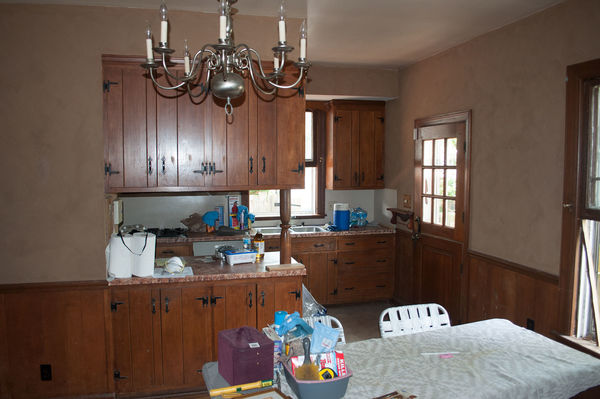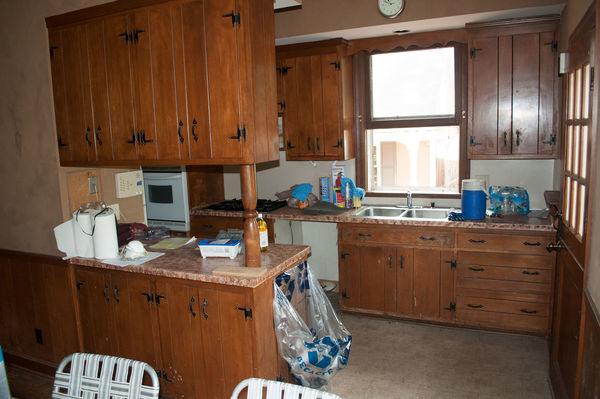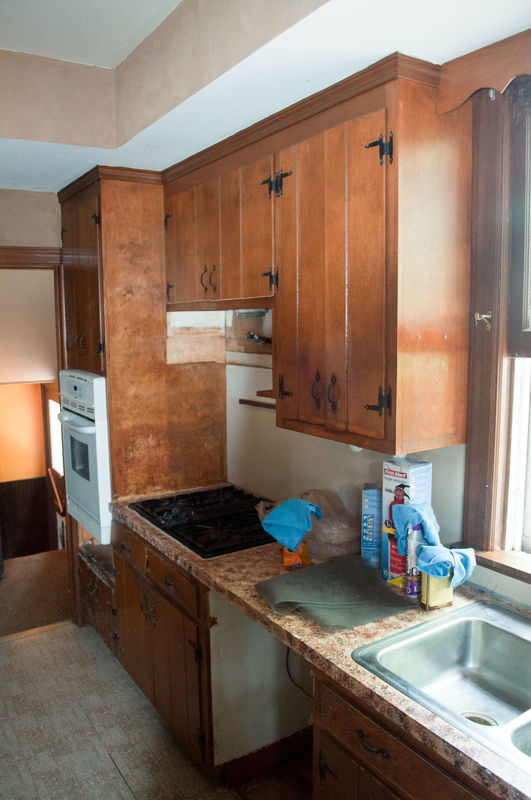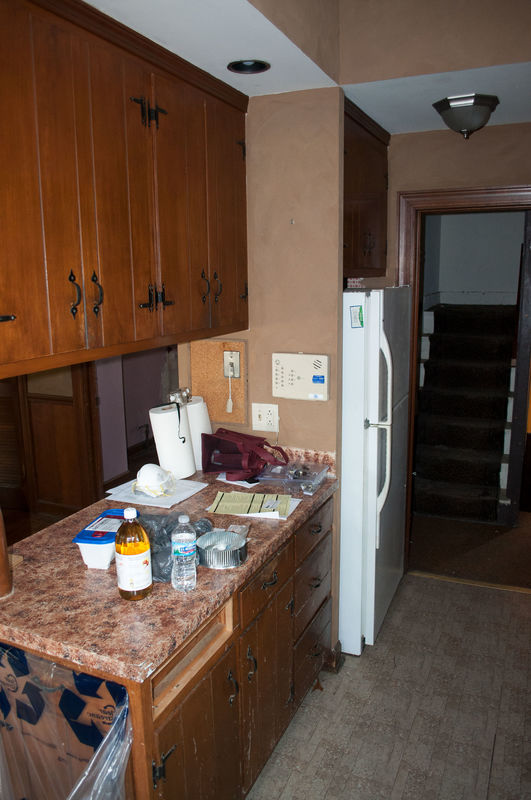White balance question
Aug 21, 2019 19:33:33 #
artBob wrote:
Here's what I don't understand. A present will assume the same color/temperature light for each exposure, no? If the room has a windows both East and West and a preset is made using white or gray in the center of the room, photos from one side will have a different set of color relationships than photos from the other it seems. Is that right?
If you set one white balance the effects of the different light color temps will show as they really are, graduated.
If you set it to auto, they may be different in each shot, which will look funny when you stitch them together to make the pano.
Aug 21, 2019 19:34:07 #
Ysarex wrote:
That's right. And that may be the best choice in a case like that with mixed light sources.
Joe
Joe
But if I set Auto WB, all my whites will be white, no? Here are four pix in which I did that, and although the light sources were not that different, still they were different.
Aug 21, 2019 19:42:05 #
Ysarex
Loc: St. Louis
artBob wrote:
But if I set Auto WB, all my whites will be white, no?
Here are four pix in which I did that, and although the light sources were not that different, still they were different.
Here are four pix in which I did that, and although the light sources were not that different, still they were different.
You appear to be firing a flash. When you use an on-camera flash the camera auto WB will set the white balance to flash.
Otherwise auto WB doesn't make white white. It uses computer algorithms to examine the content of the image you took and make a best estimate for the white balance. The software is usually good enough to make most people happy most of the time, but it can and does fail pretty badly at times.
Joe
Aug 21, 2019 20:15:50 #
Ysarex wrote:
You appear to be firing a flash. When you use an on-camera flash the camera auto WB will set the white balance to flash.
Otherwise auto WB doesn't make white white. It uses computer algorithms to examine the content of the image you took and make a best estimate for the white balance. The software is usually good enough to make most people happy most of the time, but it can and does fail pretty badly at times.
Joe
Otherwise auto WB doesn't make white white. It uses computer algorithms to examine the content of the image you took and make a best estimate for the white balance. The software is usually good enough to make most people happy most of the time, but it can and does fail pretty badly at times.
Joe
Doesn't seem like a flash to me, and I rarely use flash. I think you are right in saying camera Auto WB is "good enough to make most people happy most of the time, but it can and does fail pretty badly at times". I have shot a few exposures that need post processing for color and WB. However, I think the odds are much better for that approach than using a preset. However, not having ever done the present for such a situation, I don't know.
Aug 21, 2019 20:33:44 #
artBob wrote:
Doesn't seem like a flash to me, and I rarely use flash. I think you are right in saying camera Auto WB is "good enough to make most people happy most of the time, but it can and does fail pretty badly at times". I have shot a few exposures that need post processing for color and WB. However, I think the odds are much better for that approach than using a preset. However, not having ever done the present for such a situation, I don't know.
Try shots for pano in a room, see how it works out in Auto WB, and then "not auto" (pick one), especially with lights on in the room and daylight coming in the window(s). Stitch them together, and you'll see what everyone means. The OP was regarding panos, not individual shots.
Aug 21, 2019 22:12:23 #
Longshadow wrote:
Try shots for pano in a room, see how it works out in Auto WB, and then "not auto" (pick one), especially with lights on in the room and daylight coming in the window(s). Stitch them together, and you'll see what everyone means. The OP was regarding panos, not individual shots.
Oops, I apologize for missing the very important aspect of pano.
Aug 21, 2019 22:31:42 #
artBob wrote:
Here's what I don't understand. A present will assume the same color/temperature light for each exposure, no? If the room has a windows both East and West and a preset is made using white or gray in the center of the room, photos from one side will have a different set of color relationships than photos from the other it seems. Is that right?
Yes. But it is correct. If you’re stitching a panorama together, differences in exposure and white balance settings will be very ugly at the edge transitions.
Aug 22, 2019 06:21:45 #
burkphoto wrote:
Yes. But it is correct. If you’re stitching a panorama together, differences in exposure and white balance settings will be very ugly at the edge transitions.
Bill you are on target, and I spoke too soon. Balancing each exposure to neutral color is the only way to get this done. And being a pano, the mix of different light color will change as you create the exposures. The only way I know of for certain to mix two light sources with different colors is to use a ColorChecker Passport.
https://www.youtube.com/watch?v=NDtebpvATzc
What the whole video, but for the dual illuminant explanation fast forward to 21:30 I belive.
Aug 22, 2019 06:42:00 #
Agree.
Ysarex wrote:
Set a fixed WB. Either use one of the camera's WB presets, set temp/tint values directly if the camera allows or preferably set a custom WB that you feel appropriate for the entire room and use that.
Joe
Joe
Aug 22, 2019 06:54:27 #
tcthome
Loc: NJ
Gene51 wrote:
Bill you are on target, and I spoke too soon. Balancing each exposure to neutral color is the only way to get this done. And being a pano, the mix of different light color will change as you create the exposures. The only way I know of for certain to mix two light sources with different colors is to use a ColorChecker Passport.
https://www.youtube.com/watch?v=NDtebpvATzc
What the whole video, but for the dual illuminant explanation fast forward to 21:30 I belive.
https://www.youtube.com/watch?v=NDtebpvATzc
What the whole video, but for the dual illuminant explanation fast forward to 21:30 I belive.
with the color checker passport , aren't you supposed to take a sample shot for all the different lighting to use in post? eg. , daylight , shade, cloudy , etc. or in this case , window, led, codesant.
Aug 22, 2019 08:36:44 #
burkphoto wrote:
You can't, unless you balance the color temperatur... (show quote)
Thanks burkphoto for that great post. It sure opened my eyes to a lot of things that matter and which are not always apparent to most of us who only do this on occasion. Thank you again sir.
Jimbo
Aug 22, 2019 09:34:55 #
I always shoot RAW. I find the auto white balance my Canons is a very good starting point, and if necessary I can adjust white balance in Capture One. I prefer to use my eye for those adjustments instead of a white balance tool. Capture One allows me to adjust white balance in separate layers. This allows me to adjust the light balance if there are multiple light sources in the same frame, such as bright sunlight and shadows, or sunlight coming through a window and interior lights in part of the frame.
Aug 22, 2019 09:41:36 #
Gene51 wrote:
... Balancing each exposure to neutral color is the only way to get this done. And being a pano, the mix of different light color will change as you create the exposures. The only way I know of for certain to mix two light sources with different colors is to use a ColorChecker Passport.
https://www.youtube.com/watch?v=NDtebpvATzc
What the whole video, but for the dual illuminant explanation fast forward to 21:30 I belive.
https://www.youtube.com/watch?v=NDtebpvATzc
What the whole video, but for the dual illuminant explanation fast forward to 21:30 I belive.
We agree that all images must use the same white balance (color temperature and hue), manual ISO and exposure (aperture and shutter speed) to avoid issues with transitions between overlapping frames.
But white balance doesn't end up in the raw file. It's in the camera's SOOC JPEG and in the metadata used by your computer for the initial display of the demosaic step that turns the raw data into a visible RGB image.
That video describes a fairly complicated series of steps using the ColorChecker Passport in combination with Adobe software to incorporate just one color profile. It does not tell us how to combine two or more color profiles. Its objective is to make you want to buy and use ColorChecker Passport, not to make your life easier.
There is a much easier way to go about this if you are shooting raw:
1. Take a SWAG at the appropriate color of the light. It doesn't have to be exact, just close. For example
http://blueskyinternational.com.co/wp-content/uploads/2019/05/kelvin-color-scale-light.jpg
2. Shoot all of the images with the same ISO, exposure and white balance.
3. Load all of the images into your raw editor. There is a good chance that if there was more than one light source they are not all going to look neutral.
4. Adjust the exposure slider or highlight/shadow recovery, etc., identically for all of the images until you find a compromise rendition.
5. Change the color temperature °K identically until you find a compromise for the yellow/blue balance. There is no way you will ever get all of them to look balanced with different light sources producing a neutral gray. You just have to find a happy medium.
6. If the images still have a problem with the tint (green/magenta) balance, change the tint in all of them by the same amount.
7. Finally, merge the images in your panorama software.
Aug 22, 2019 09:46:31 #
Agree: "Its objective is to make you want to buy and use ColorChecker Passport." Shills push the marketing agenda of buying this accessory.
selmslie wrote:
We agree that all images must use the same white b... (show quote)
Aug 22, 2019 09:59:07 #
You have to remember that if shooting JPEG *or* RAW, if you set the camera on auto-(anything) the camera will "look at and analyze" the scene and make *its* decision as to what it *thinks* your intentions are. (In JPEG that includes WB. Not so much in RAW) Especially in JPEG mode, you *must* give the camera clear instructions as to what you want - meaning you have to shoot in manual(everything) mode. Otherwise, you will get differences, sometimes very large, sometimes very subtle, from shot to shot.
If you want to reply, then register here. Registration is free and your account is created instantly, so you can post right away.











